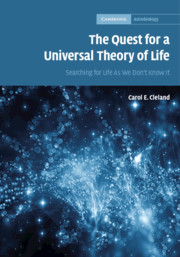Refine listing
Actions for selected content:
17000 results
4 - How Scientific Theories Develop
-
- Book:
- The Quest for a Universal Theory of Life
- Published online:
- 05 September 2019
- Print publication:
- 12 September 2019, pp 82-104
-
- Chapter
- Export citation
7 - Artificial Life: Could ALife Solve the N = 1N=1 Problem?
-
- Book:
- The Quest for a Universal Theory of Life
- Published online:
- 05 September 2019
- Print publication:
- 12 September 2019, pp 161-171
-
- Chapter
- Export citation
3 - What Is a Scientific Theory?
-
- Book:
- The Quest for a Universal Theory of Life
- Published online:
- 05 September 2019
- Print publication:
- 12 September 2019, pp 63-81
-
- Chapter
- Export citation
8 - Searching for Extraterrestrial Life Without a Definition or Universal Theory of Life
-
- Book:
- The Quest for a Universal Theory of Life
- Published online:
- 05 September 2019
- Print publication:
- 12 September 2019, pp 172-194
-
- Chapter
- Export citation
Acknowledgments
-
- Book:
- The Quest for a Universal Theory of Life
- Published online:
- 05 September 2019
- Print publication:
- 12 September 2019, pp xii-xiv
-
- Chapter
- Export citation
Conclusion
-
- Book:
- The Quest for a Universal Theory of Life
- Published online:
- 05 September 2019
- Print publication:
- 12 September 2019, pp 217-219
-
- Chapter
- Export citation
6 - Rethinking the Traditional Paradigm for Life: Lessons from the World of Microbes
-
- Book:
- The Quest for a Universal Theory of Life
- Published online:
- 05 September 2019
- Print publication:
- 12 September 2019, pp 132-160
-
- Chapter
- Export citation
References
-
- Book:
- The Quest for a Universal Theory of Life
- Published online:
- 05 September 2019
- Print publication:
- 12 September 2019, pp 220-242
-
- Chapter
- Export citation
Reviews
-
- Book:
- The Quest for a Universal Theory of Life
- Published online:
- 05 September 2019
- Print publication:
- 12 September 2019, pp ii-ii
-
- Chapter
- Export citation

The Quest for a Universal Theory of Life
- Searching for Life As We Don't Know It
-
- Published online:
- 05 September 2019
- Print publication:
- 12 September 2019
Dedication
-
- Book:
- An Introduction to Radio Astronomy
- Published online:
- 06 August 2019
- Print publication:
- 22 August 2019, pp v-vi
-
- Chapter
- Export citation
Index
-
- Book:
- An Introduction to Radio Astronomy
- Published online:
- 06 August 2019
- Print publication:
- 22 August 2019, pp 517-524
-
- Chapter
- Export citation
11 - Further Interferometric Techniques
- from Part II - Radio Telescopes and Aperture Synthesis
-
- Book:
- An Introduction to Radio Astronomy
- Published online:
- 06 August 2019
- Print publication:
- 22 August 2019, pp 266-298
-
- Chapter
- Export citation
Chapter 1 - Introduction
-
- Book:
- The Atlas of Mars
- Published online:
- 16 August 2019
- Print publication:
- 22 August 2019, pp 1-3
-
- Chapter
- Export citation
Sinus Sabaeus (MC-20)
- from Map Sheets
-
- Book:
- The Atlas of Mars
- Published online:
- 16 August 2019
- Print publication:
- 22 August 2019, pp 176-179
-
- Chapter
- Export citation
Latin Descriptors
- from Appendix
-
- Book:
- The Atlas of Mars
- Published online:
- 16 August 2019
- Print publication:
- 22 August 2019, pp 250-250
-
- Chapter
- Export citation
Glossary of Terms
- from Appendix
-
- Book:
- The Atlas of Mars
- Published online:
- 16 August 2019
- Print publication:
- 22 August 2019, pp 251-253
-
- Chapter
- Export citation
Preface
-
- Book:
- The Atlas of Mars
- Published online:
- 16 August 2019
- Print publication:
- 22 August 2019, pp vii-vii
-
- Chapter
- Export citation
SI/English Unit Conversions
- from Appendix
-
- Book:
- The Atlas of Mars
- Published online:
- 16 August 2019
- Print publication:
- 22 August 2019, pp 247-249
-
- Chapter
- Export citation
How to Use this Atlas
-
- Book:
- The Atlas of Mars
- Published online:
- 16 August 2019
- Print publication:
- 22 August 2019, pp ix-ix
-
- Chapter
- Export citation
